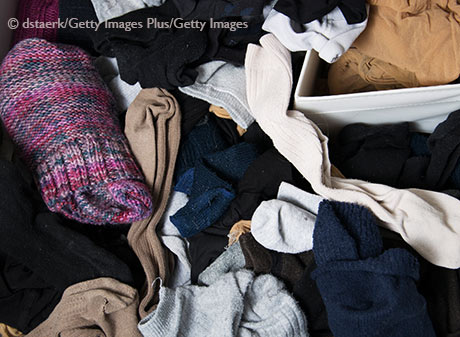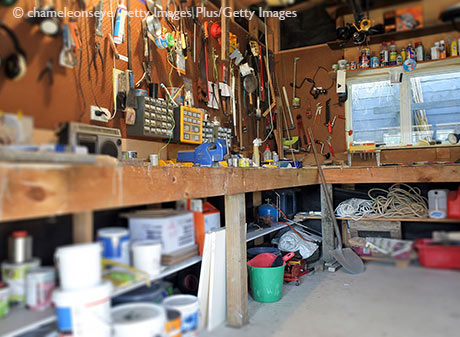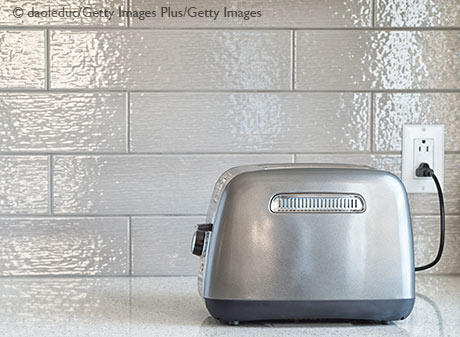An Economist's Guide to Tidying Up
Tidying up is a cultural phenomenon thanks to Marie Kondo’s books and Netflix show. Her KonMari method counsels consumers to painstakingly sort through possessions. It starts with clothing, progresses to books, paper and komono (miscellany in the kitchen, bathroom, garage, etc.), and culminates with sentimental items.
People are to hold an item and determine whether it “sparks joy”—akin to the warm fuzzies you get holding a puppy.
But for those eager to organize their lives, is there another way? We asked St. Louis Fed economists and research associates how the dismal science of economics might help.
Call it EconMari.
Clutter is in the eye of the beholder (but matching socks are not)
Contributed by: Cletus Coughlin, Economist, Senior Vice President and Chief of Staff
A thought I had on the Marie Kondo phenomenon, because I heard about it from my wife and daughter: A lot of her advice isn’t just how to throw stuff out, it’s about an organization method. How do you organize your sock drawer?
In terms of organization, you’re engaging in an investment.

The economist’s point of view is that you’re incurring some costs now—spending time organizing things—and deferring some gratification in anticipation of a payoff down the road. You’ll benefit later from being able to access your socks quicker. You won’t mistake a black sock for a blue one. (Although, given my experiences with economists, I am happy if they are simply wearing socks at work.)
Now, if you were to observe my office, you’d likely say, “Oh, he’s disorganized.” Even though it looks cluttered, every separate pile is a particular project I’m working on. It’s organized enough for me to get what I need. There becomes an issue of, how do you file things? If you have something that is dated, it’s pretty easy to file. Either put it at the front or put it at the back. As long as you’re consistent, you’ll be able to find everything.
With most of what I’m working on, the time dimension is only because I had it in my hand most recently. The rationality of that is: If I just touched it, there’s a good chance I’m going to touch it again right away. So it might be easier to find that way as opposed to spending the time to put it in the right place. (Some things, such as the files in my storage closet, it’s highly unlikely I’m going to touch them. But at least I know where they are. When I get dragged out of here someday, I’ll probably throw them away. For now, no one is going to go over to my closet … unless I’m in there hiding from them.)
When it comes to stuff you don’t use—or as Kondo says, doesn’t “spark joy”—if you have a tuxedo, which I don’t, I would still keep the tuxedo even though I might only wear it every few years. I’m not sure about this whole “throw it out if it doesn’t spark joy.”
But in terms of “does this make economic sense?” you don’t want to throw out something like a tuxedo because it’s a pain to buy a new one. Think about the cost.
You should assess the utility and storage costs of keeping that yard seed.
Contributed by: Michael McCracken, Economist and Assistant Vice President
“Sparks joy” has a very short-run flavor to it. While there are static models in economics, most are dynamic and occur across time. In such models, the goal is to optimize total utility across time and not just what we obtain “today.”
The half bag of leftover yard seed in my garage is not sparking joy today, but in the fall, when I want to overseed the lawn, having it will provide utility:
- I will not have to buy more seed and can, instead, spend my money on beer.
- I will not have to go to the store and deal with the crowds; instead, I can stay at home and drink my beer.

That said, storage costs are a real thing. In this example, I have plenty of space in my garage to keep the half bag of seed. If I didn’t have the extra space, I would have to keep the bag elsewhere—like the basement, and thus use up that space—or throw something away to create space. Either way, it costs me something; if either of those “costs” are high enough, I would be better off throwing away the half bag of seed.
Put differently, in the first part, the issue is largely about accurately assessing the benefits of keeping stuff. In the second, the issue is largely about assessing the costs. Economics is all about managing the tradeoff between the two, and space is a scarce resource in any home.
Think about the option value of your little-used stapler.
Contributed by: Guillaume Vandenbroucke, Economist and Research Officer, and Makenzie Peake, Research Associate
Overall, economic theory is not meant to give guidance on how to lead one's life. Economists are just as good (or as bad) as the next guy in this domain. Even though economic theory does not help me to decide whether I should be tossing away the useless stuff piling up in my home, it does help to think about the tradeoffs associated with these decisions.

There are three kinds of goods:
- Those that we use regularly and have an undeniable practical value, like a fork and plate.
- Those that you don't “use” but you enjoy having, like the picture of a family member. Some people would say these goods have sentimental value.
- Finally, there's the rest, like that broken lawn mower in your garage, or someone’s barely used stapler on their desk.
One view is to say that by revealed preference, if you keep it, it’s because you want to. End of discussion. That’s only true, however, if the cost of getting rid of the offending object is zero. Then revealed preference applies: You could get rid of it but you don't, ergo you like to keep it. But sometimes getting rid of things is not that cheap. So, keeping something totally useless may make sense if it’s cheaper than tossing it away.
About that barely used stapler: The concept that comes into mind is the option value. You may use it one day and, therefore, you may not want to get rid of it. It’s a bit like someone living in New York City for all the amenities they're never using. They might one day, though, so it makes sense to live there.
What does Marie Kondo do? Either she reduces the cost of tossing things away, or she makes people reassess the option value they attach to apparently useless things.
If you purge that sundress, will you lose future utility?
Contributed by: Hannah Shell, Senior Research Associate
Tidying up in economic terms would involve identifying the costs associated with keeping an item versus the costs associated with getting rid of it. The costs associated with keeping items could be storage space, cleaning time and visual aesthetics (more items, more clutter).

The costs associated with getting rid of an item might be replacement costs, if it’s a daily-use or even occasional-use item; lost sentimental value; removal costs if it’s a large item; and lost future utility from continued consumption.
If I’m deciding whether to get rid of an old sundress, I’ll think about how likely I am to wear it in the future, whether I have room in my closet, or if there is sentimental value (perhaps a gift from a family member).
If I’m not likely to wear it again and I want extra space, it’s an easy decision to get rid of it. There’s little future utility to be consumed from a dress I don’t expect to wear again, and I likely won’t have any replacement costs.
Evaluate your toaster’s market value and depreciation.
Contributed by: Ryan Mather, Research Associate
I came across this quote by Margaret Dilloway, who wrote about the KonMari method and her own upbringing with a Japanese mother who practiced the Shinto religion: “Treasuring what you have; treating the objects you own as not disposable, but valuable, no matter their actual monetary worth … are all essentially Shinto ways of living."
Treating an object’s value to the holder as separate from its monetary—or “market”—value is central to economics.

The classic example is a bottle of water you bought for $2. If you are thirsty enough, that water may have been worth $4 to you. The difference between what you would have paid and what you did pay is called consumer surplus (you paid for $2 of “joy” and received another $2 for free).
Now, should you find yourself in a crowd of thirsty people, each of whom is willing to pay $6, it no longer makes sense for you to hold on to that bottle. By selling it, you lose $4 of “joy” and receive $6. The opportunity is better. The difference between the opportunity’s value and the actual value is called the opportunity cost.
Returning to Kondo, every object in your life has value in this way and should be sold or kept depending upon how its personal value relates to market value.
Goods can be separated into durable and nondurable, with the difference being that nondurable goods depreciate rapidly with time or use. With very few exceptions, though, even durable goods are constantly depreciating whether you use them or not. Using the reasoning above, the true value of a good you are not using (and do not intend to use) is already negative because of the opportunity cost. Add on depreciation, and that negative value just gets worse.
An example: If I have a durable good, perhaps a toaster, worth $4 that I am not using, then that is $4 of my property which could be converted into cash (or at the very least enjoyed by someone else) that I am wasting. To make matters worse, not only am I missing out on $4 today, but next year when I wake up to my need to sell this toaster, its value will be less. If it has depreciated to $3, than I will have incurred a loss of $1 that can never be taken back.
Ooh, the drama of toasters.
In summary …
In summary, how you decide to tidy up your home is an individual choice. To get the ball rolling, Senior Research Associate Joseph McGillicuddy encourages consumers to think of the alternatives to keeping an item:
“You could sell your old clothes and earn money back to spend on things that would give you more value. Or, you could donate them and feel good about helping people in need.”
And to avoid introducing clutter in the first place, Senior Research Associate Andrew Spewak offers this:
“Time, money and energy limitations are often outside your control. All you can do is maximize what you get given your external constraints. Like, if you’re about to buy a new pair of shoes, don’t just think about whether it’s worth the monetary cost on the price tag; consider whether it’s worth more to you than something else you could buy with the same amount of money. Considering your next-best alternative will help you maximize the happiness you get out of your limited dollars.”
Speaking of happiness, next week we pose a deeper question to our colleagues: How does your expertise in economics inform your sense of joy?
More to Explore
This blog explains everyday economics and the Fed, while also spotlighting St. Louis Fed people and programs. Views expressed are not necessarily those of the St. Louis Fed or Federal Reserve System.
Email Us



